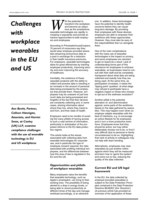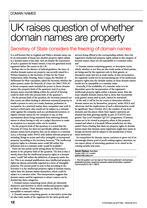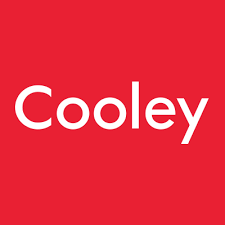Description
Point of View
Patents can represent an intersection between technology and business, and considering how an
invention connects to revenue can
be important. When the connection
is direct and the revenue meaningful, pursuing patent protection likely
makes sense. When the connection
is inchoate or the revenue is less
meaningful, patent protection likely
makes less sense. Being able to articulate this connection to revenue
typically helps in the cost-benefit
assessment on whether to pursue
patent protection.
For example, for a single-product company where the invention can be directly attributable to the company’s entire revenue such as a startup medical device company, the benefit of patent protection can easily outweigh the cost of pursuing patent protection. For a multiproduct company where the invention relates to small or declining revenue source, the benefit of patent protection may not outweigh the costs. For another example, for an invention that covers a key technology or a technology chokepoint where an alternative commercial product or service is not possible without the invention, the benefit of patent protection can be great.
For an invention that covers an ancillary feature such as an optional software feature, patent protection is less compelling. Patents define the scope of rights for inventions, thus determine the extent to which competitors can possibly avoid patents while providing commercially similar products or services. When the scope of those patent rights are broad, competitors cannot easily design around the patent rights with comparable products and services and thus the desirability of pursuing patent protection is greater. When the scope of those patent rights are narrow, competitors can more easily design around the patent rights, and the desirability of pursuing patent protection is less. Detectability of infringement is also an important factor when considering whether to pursue patent protection.
Some inventions can be easy to observe, for example, when outwardly visible to the endconsumer such as a user interface or an electronics device with outwardly observable features. Other inventions can be difficult to observe, for example, when located in firmware, an applications-specific integrated circuit, source code, or cloud-based software. If a competitor copies a patented invention that is difficult to observe, it can be difficult to know whether to assert the patent rights. In other words, the effectiveness of a patent can be lower if you cannot tell when it is infringed. I II .
ADDITIONAL POSSIBLE REASONS TO NOT PURSUE PATENT PROTECTION Finally, with all of the aforementioned possible reasons for pursuing patent protection, it is worth considering some of the reasons for not pursuing patent protection. Some such reasons can include competing on different bases, a short product life, and certain situations involving open-source software. Each is discussed below briefly. As discussed above, patents can be considered as a “barrier to entry” to prevent competitors from entering the marketplace.
But, other forms of barrier to entry exist separate from patent protection. For example, for some companies in burgeoning industries, being first to market may be a sufficient barrier to entry to prevent later competitors from entering the market. When such alternative barrier to entry exists and is sufficient, patents may be unnecessary. The product life can also effect the decision on whether to pursue patent protection.
Although it is possible to expedite the examination process within the U.S. Patent Office, the average nonexpedited examination time is about three years. For products or services that have a short life, these products or services will run their course before the patent is issued and provides protection.
In such a situation, pursuing patent protection may not make sense. When developing software-based inventions, the inventors need to consider whether to develop and sell the software under an open-source license. Under certain open-source licenses, such software-based inventions are available to others under the open-source license. As such, pursuing patent protection may make less sense in this situation.
In other words, when the softwarebased inventions are available to others under an open-source license, patents cannot exclude competitors that properly use the software-based inventions under the open-source license. In such situations, patent protection, if pursued, can serve more limited purposes, for example, to exclude competitors that use the software-based invention outside the open-source license. IV. CONCL US ION As discussed above, the decision on whether it makes sense to pursue patent protection for an invention is multifaceted.
It may be helpful to first identify the reasons for possibly pursuing patent protection, and then to next consider the particular factors unique to the invention. At this point, one may have a better understanding on when it makes sense to pursue patent protection and when it does not. h Vol.
104, No. 3, March 2016 | Proceedings of the IEEE 481 .
For example, for a single-product company where the invention can be directly attributable to the company’s entire revenue such as a startup medical device company, the benefit of patent protection can easily outweigh the cost of pursuing patent protection. For a multiproduct company where the invention relates to small or declining revenue source, the benefit of patent protection may not outweigh the costs. For another example, for an invention that covers a key technology or a technology chokepoint where an alternative commercial product or service is not possible without the invention, the benefit of patent protection can be great.
For an invention that covers an ancillary feature such as an optional software feature, patent protection is less compelling. Patents define the scope of rights for inventions, thus determine the extent to which competitors can possibly avoid patents while providing commercially similar products or services. When the scope of those patent rights are broad, competitors cannot easily design around the patent rights with comparable products and services and thus the desirability of pursuing patent protection is greater. When the scope of those patent rights are narrow, competitors can more easily design around the patent rights, and the desirability of pursuing patent protection is less. Detectability of infringement is also an important factor when considering whether to pursue patent protection.
Some inventions can be easy to observe, for example, when outwardly visible to the endconsumer such as a user interface or an electronics device with outwardly observable features. Other inventions can be difficult to observe, for example, when located in firmware, an applications-specific integrated circuit, source code, or cloud-based software. If a competitor copies a patented invention that is difficult to observe, it can be difficult to know whether to assert the patent rights. In other words, the effectiveness of a patent can be lower if you cannot tell when it is infringed. I II .
ADDITIONAL POSSIBLE REASONS TO NOT PURSUE PATENT PROTECTION Finally, with all of the aforementioned possible reasons for pursuing patent protection, it is worth considering some of the reasons for not pursuing patent protection. Some such reasons can include competing on different bases, a short product life, and certain situations involving open-source software. Each is discussed below briefly. As discussed above, patents can be considered as a “barrier to entry” to prevent competitors from entering the marketplace.
But, other forms of barrier to entry exist separate from patent protection. For example, for some companies in burgeoning industries, being first to market may be a sufficient barrier to entry to prevent later competitors from entering the market. When such alternative barrier to entry exists and is sufficient, patents may be unnecessary. The product life can also effect the decision on whether to pursue patent protection.
Although it is possible to expedite the examination process within the U.S. Patent Office, the average nonexpedited examination time is about three years. For products or services that have a short life, these products or services will run their course before the patent is issued and provides protection.
In such a situation, pursuing patent protection may not make sense. When developing software-based inventions, the inventors need to consider whether to develop and sell the software under an open-source license. Under certain open-source licenses, such software-based inventions are available to others under the open-source license. As such, pursuing patent protection may make less sense in this situation.
In other words, when the softwarebased inventions are available to others under an open-source license, patents cannot exclude competitors that properly use the software-based inventions under the open-source license. In such situations, patent protection, if pursued, can serve more limited purposes, for example, to exclude competitors that use the software-based invention outside the open-source license. IV. CONCL US ION As discussed above, the decision on whether it makes sense to pursue patent protection for an invention is multifaceted.
It may be helpful to first identify the reasons for possibly pursuing patent protection, and then to next consider the particular factors unique to the invention. At this point, one may have a better understanding on when it makes sense to pursue patent protection and when it does not. h Vol.
104, No. 3, March 2016 | Proceedings of the IEEE 481 .
Regulations Presentations
+
Regulations Sub Categories














